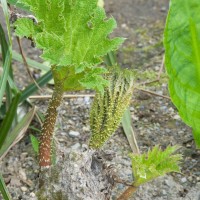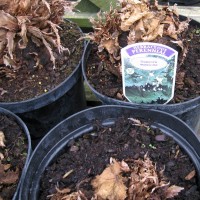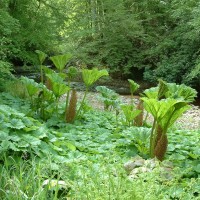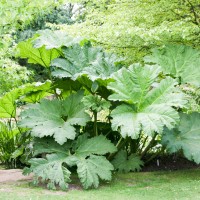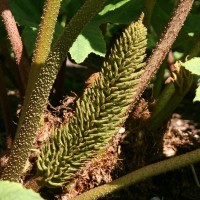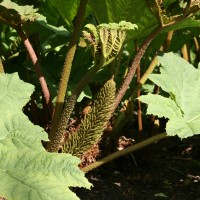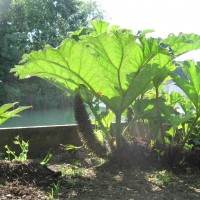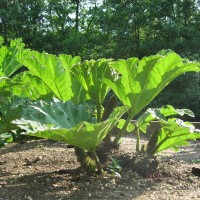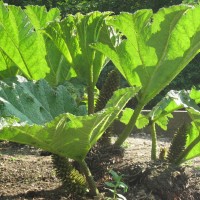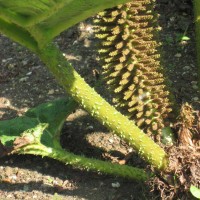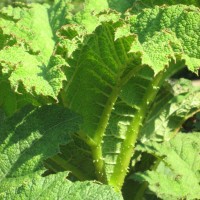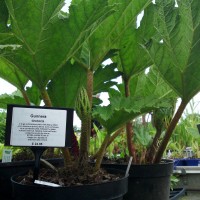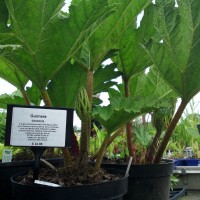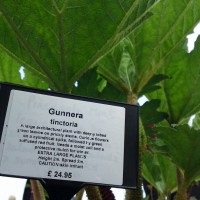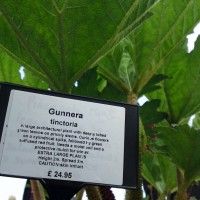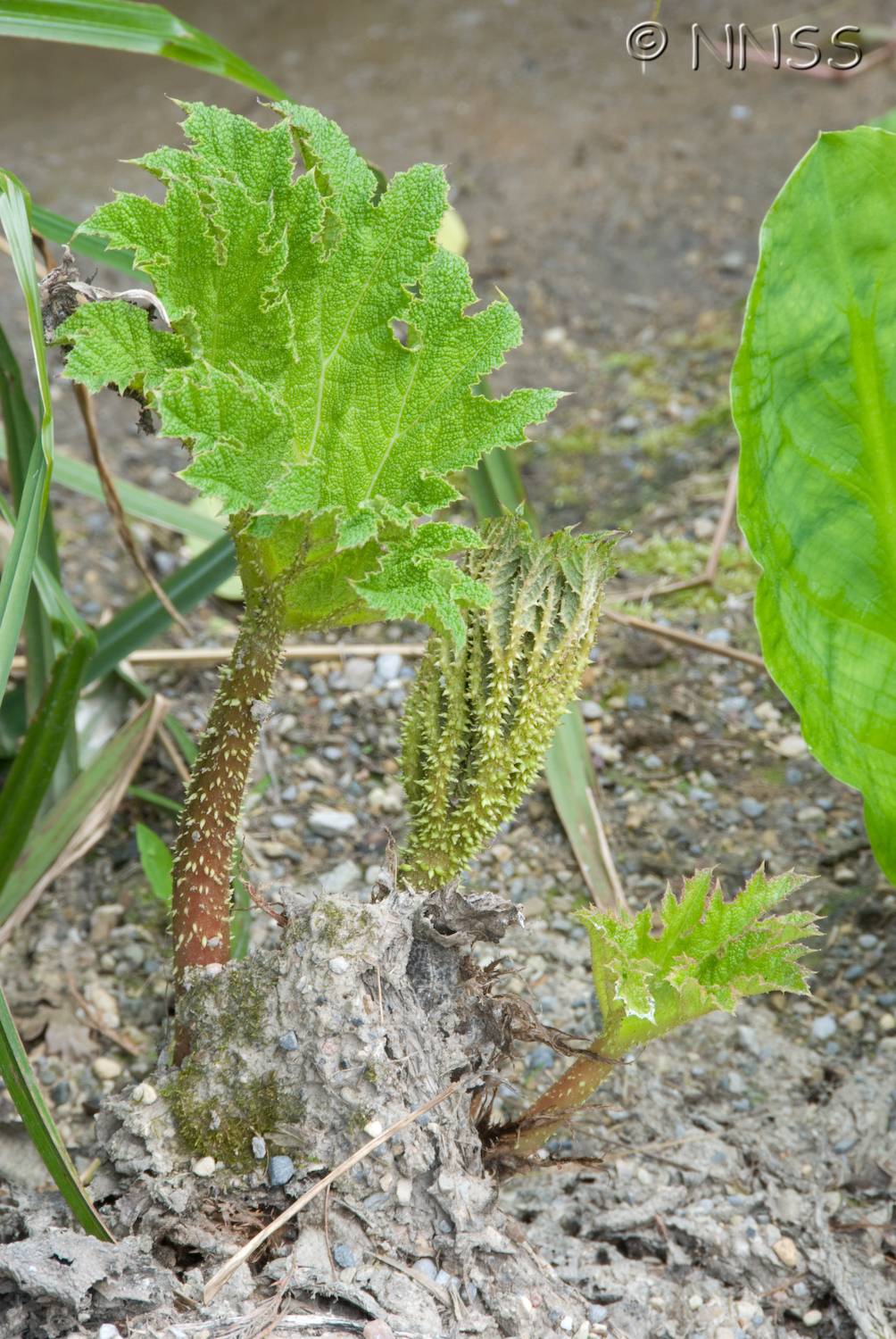
Giant Rhubarb - Gunnera tinctoria
Expand and collapse the sections below by clicking on the title or + / - icons.
Short description of Gunnera tinctoria, Giant Rhubarb
It is a fast-growing clump-forming perennial herb which can grow up to 2m in height and has huge leathery leaves with cordate bases arising from a stout brown scaly rhizome. The leaf stalks bear short pale bristles and weak spines. Tiny flowers are borne on erect, cone-like compound inflorescences up to 1m long, followed by hundreds of densely packed small red-orange fruits; each plant has up to five inflorescences.
Impact summary: Gunnera tinctoria, Giant Rhubarb
It forms dense clumps which out-compete native vegetation, disrupt ecosystems and halt natural succession. It traps litter and looks unsightly in winter when it dies back, can contribute to local flooding by blocking drains and streams and can dominate large tracts of agricultural land.
Habitat summary: Gunnera tinctoria, Giant Rhubarb
In a range of sunny or partly shaded sheltered habitats on permanently wet soils. It grows best in temperate areas with high rainfall.
Overview table
| Environment | Terrestrial |
|---|---|
| Species status | Non-Native |
| Native range | Southern America, Southern South America |
| Functional type | Land plant |
| Status in England | Non-Native |
| Status in Scotland | Non-Native |
| Status in Wales | Non-Native |
| Location of first record | |
| Date of first record | 1908 |
Origin
It is native to South America from Colombia to Chile.
First Record
Giant-rhubarb was established in the wild by at least 1908 and it had escaped into the wild in Ireland by at least 1939.
Pathway and Method
Introduced into cultivation in 1849, it has been widely promoted as a popular architectural ornamental for use around ponds and in damp areas and has been awarded an Award of Garden Merit by the Royal Horticultural Society. However, its large stature means that it quickly outgrows all but the largest gardens and estates.
Species Status
It is locally naturalised in parts of GB and is considered to be invasive in some western areas including Cornwall and the west of Ireland. Its spread prior to 1986 was slow; between 1987 and 1999 it increased greatly, especially in Ireland, and by 1999 it had been recorded in 169 10km squares across the British Isles. Some occurrences may have been erroneously recorded as G. manicata, which is the more frequent species in Devon. Giant-rhubarb is also naturalised in many other countries, including Australia and New Zealand (where it is very troublesome), the United States and Canada, France and Portugal.
Dispersal Mechanisms
The plant can reproduce by both sexual and asexual means. Each mature plant is capable of producing up to 250,000 seeds every year which are then distributed by birds, water and human activity such as the transport and movement of soil containing the seeds. It can also regenerate from small fragments of rhizome, which, once established, can extend by 15cm a year.
Reproduction
In summer, Giant-rhubarb bears large numbers of small flowers on cone-shaped inflorescences which are pollinated by bees and other insects over an extended period. Large numbers of small orange/red fruits containing a single ovoid and flanged seed follow and mature in late summer to early autumn. Viability of fresh seed, especially in western parts of Ireland, appears to be high. In places with a cool, wet climate, plants can reach sexual maturity within a few years.
Known Predators/Herbivores
It has no significant predators or herbivores.
Resistant Stages
Seed appears to have high germination potential whether it has fallen close to the parent plant or passed through the digestive tract of a bird. In winter, leaves wither to expose thick brown rhizomes which are capable of producing new plants if detached from the parent and which bear massive over-wintering buds. It is not known how long detached pieces of rhizome can survive.
Habitat Occupied in GB
It prefers constantly damp soils and grows in full sun or part shade in wet grassland and rush-pasture, woodland and scrub, on sheltered banks of rivers, streams and lakes and on sheltered soft sea cliffs. In the west of Ireland it can also be abundant on road verges, quarries, mire and heath, and forms large continuous stands across former agricultural land.
Most frequent in western parts of GB, with particular localised concentrations in Cornwall and along the western seaboard of Ireland.
Environmental Impact
Once established, Giant-rhubarb can quickly develop large and dense colonies of massive plants 2m high. Native vegetation is displaced and whole ecosystems can be destroyed or altered in a large way. The plant also replaces Grey Willow Salix cinerea and alters the natural process of vegetation succession. Of particular concern is the plant’s spread in habitats of high ecological importance, such as in species-rich wet grassland, in mire and heath and along watercourses. When it grows on soft coastal cliffs it contributes to erosion and loss of native maritime species when plants fall down to the bottom due to their great weight, carrying soil and rock with them. The plant has a symbiotic relationship with nitrogen-fixing cyanobacteria in its rhizomes and this may confer an advantage to young plants growing in nitrogen-deficient soils.
Health and Social Impact
Plants are not poisonous to humans but the leaf blade and stem bear stiff bristles which can scratch skin. In summer the large size of the plants is often visually disjunct with the surrounding vegetation. In winter, the large brown rhizomes are exposed and look unsightly and this is compounded when they trap litter. There have also been reports that decaying leaves sometimes cause an unpleasant odour.
Economic Impact
Giant-rhubarb can block drains and streams, increasing the risk of local flooding. Loss of land can also be a problem in some areas such as western Ireland where it forms extensive stands on farmland. It is very difficult and costly to eradicate and can be an economic burden to local authorities, landowners and organisations charged with its management. Its presence is also likely to depress land and property values and deter development interest in some places.
Identification
Stace, C.A. (2010) New flora of the British Isles, Third Edition, Cambridge University Press, Cambridge.
Biology, ecology, spread, vectors
Williams, P.A., Ogle, C.C., Timmins, S.M., LaCock, G.D. & Clarkson J. (2005) Chilean Rhubarb (Gunnera tinctoria): biology, ecology and conservation impacts in New Zealand. New Zealand Department of Conservation.
Distribution map from the NBN Gateway: www.searchnbn.net/searchengine/search.jsp?tab=1&pg=1&searchTerm=Gunnera+tinctoria
Global Invasive Species Database: www.invasivespecies.net/database/species
Management and impact
Invasive Species Action Plan (Ireland): www.invasivespeciesireland.com
National Botanic Gardens of Ireland: www.botanicgardens.ie/gunnera/gunneracontrol.htm
General
Preston, C.D., Pearman, D.A. & Dines, T.D. (2002) New Atlas of the British and Irish Flora, Oxford University Press, Oxford.
Spotted this species?
Distribution map
View the Distribution map for Giant Rhubarb, Gunnera tinctoria from BSBI
Risk assessment
Risk assessment for Gunnera tinctoria. See a full list of non-native species Risk assessments.
ID Sheet
ID Sheet for Gunnera tinctoria. See a full list of non-native species ID Sheets.
Legislation
This species is:
- A Species of Special concern
- Listed under Schedule 9 of the Wildlife and Countryside Act 1981
Read more about Non-native species legislation.

